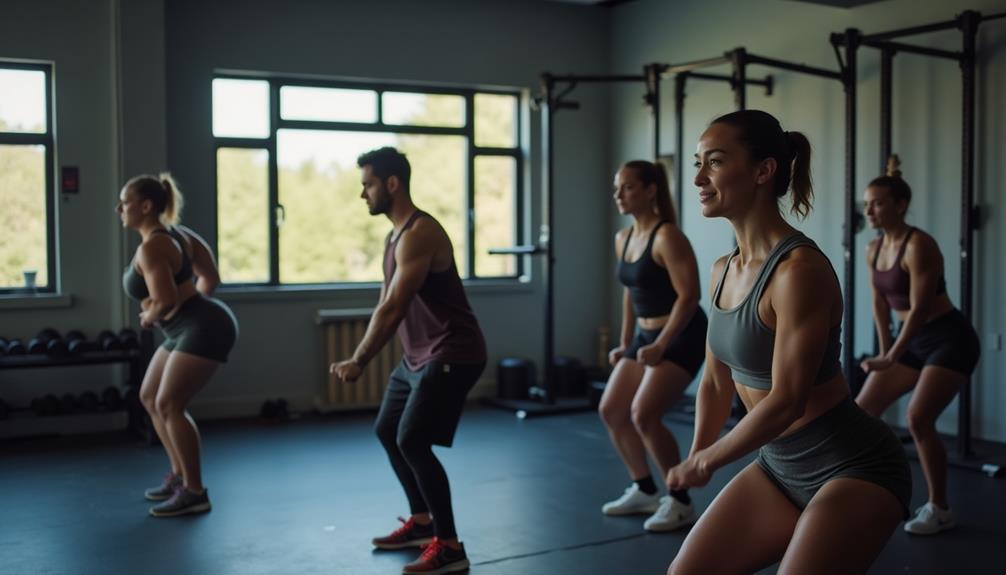Compound exercises are movements that work multiple muscle groups and joints simultaneously, making them a cornerstone of resistance training. Unlike isolation exercises, which target a single muscle group, compound exercises like squats, deadlifts, and bench presses engage several muscles at once, enhancing efficiency. They improve strength, coordination, and balance, and mimic real-life actions, boosting overall performance. To get started, always warm up, use lighter weights, and focus on proper form to avoid injury. By incorporating these exercises into your routine, you can maximize your workout benefits. Discover more about mastering these movements and their advantages as you explore further.
Core Insights
- Compound exercises involve movements that engage multiple muscle groups and joints simultaneously, enhancing workout efficiency.
- Common examples include squats, deadlifts, bench presses, and pull-ups, targeting various muscle groups.
- Resistance training with compound exercises can boost metabolism and improve overall strength, coordination, and balance.
- Proper technique and gradual weight increases are essential for safety and effectiveness when performing these exercises.
- Incorporating compound exercises into a workout routine can enhance daily activity performance and overall fitness results.
Definition of Compound Exercises

In the domain of resistance training, compound exercises are movements that engage multiple muscle groups and joints simultaneously. These exercises differ from isolation exercises, which target a single muscle group. When you perform compound exercises, you're not just working one muscle; you're activating several at once, which can lead to more efficient workouts. Resistance tubes, offering various resistance levels, can be an excellent tool for performing compound exercises, providing versatility and portability for a full-body workout. The stackable nature of these tubes allows for customization of resistance, making them suitable for both beginners and advanced users.
Common examples include squats, deadlifts, and bench presses. Each of these movements requires coordination among various muscles and joints, enhancing overall strength and functional fitness. Additionally, compound exercises mimic everyday activities, making them practical for daily life. By incorporating these movements into your routine, you can maximize your training effectiveness while saving time. So, if you want to get stronger and more efficient, consider adding compound exercises to your regimen.
Key Benefits of Compound Exercises

Compound exercises offer numerous benefits that make them a cornerstone of effective resistance training. By engaging multiple muscle groups simultaneously, you'll maximize your workout efficiency. Here are some key advantages:
- Time-saving: You'll achieve more in less time by working several muscles at once.
- Functional strength: These exercises mimic real-life movements, enhancing your daily activities and overall performance.
- Increased calorie burn: The intensity of compound movements boosts your metabolism, aiding in weight management.
To enhance your compound exercise routine, consider incorporating mobility tools designed for athletes. These tools can help improve your range of motion and flexibility, allowing for better form and increased benefits from compound movements.
Incorporating compound exercises into your routine can elevate your training results. You'll not only build strength but also improve coordination and balance. As you progress, you'll find that these exercises help you achieve a well-rounded fitness level, making them an essential part of any resistance training regimen.
Common Types of Compound Exercises

Resistance training includes a variety of compound exercises that target multiple muscle groups, helping you build strength and improve performance. Some common types of compound exercises include the squat, deadlift, bench press, and pull-up. Resistance trainers can enhance the effectiveness of these exercises by adding variable resistance, making them suitable for all fitness levels.
The squat works your legs, glutes, and core, making it a foundational movement. The deadlift engages your back, legs, and grip strength, promoting overall stability. The bench press primarily targets your chest, shoulders, and triceps, making it essential for upper body strength. Finally, the pull-up challenges your back, biceps, and core, promoting upper body power.
Incorporating these exercises into your routine can enhance functional fitness and increase muscle mass, leading to better overall physical performance. Make sure to include them for balanced strength development.
How to Perform Compound Exercises

How can you ensure that you're performing compound exercises safely and effectively? It's essential to focus on proper form and technique. Here are some key points to keep in mind:
- Warm Up: Always start with a warm-up to prepare your muscles and joints.
- Start Light: Begin with lighter weights until you're familiar with the movements, then gradually increase the load.
- Engage Core: Maintain engagement of your core throughout the exercise to sustain stability and prevent injury.
Tips for Incorporating Compound Exercises

Incorporating compound exercises into your workout routine can greatly enhance your strength and efficiency. Start by selecting a few key compound movements like squats, deadlifts, or bench presses. Aim to include these exercises two to three times a week.
Next, focus on proper form. It's essential to master the technique before increasing weights. You might consider working with a trainer if you're unsure.
Additionally, pair compound exercises with isolation movements for a balanced workout. This combination helps target specific muscles while building overall strength.
Lastly, listen to your body. If you feel fatigued or sore, adjust your routine accordingly. Gradually increasing your weight will help you avoid injury and guarantee steady progress.
Safety Considerations for Compound Exercises

- Warm Up Properly: Always start with a proper warm-up to prepare your muscles and joints.
- Use Proper Form: Focus on maintaining good technique throughout each movement to avoid unnecessary stress on your body.
- Choose Appropriate Weights: Select weights that challenge you but allow you to complete the exercises safely.
Frequently Asked Questions
Can Compound Exercises Help With Weight Loss?
Imagine a roaring fire, consuming logs with fierce energy. That's what compound exercises do for your metabolism. They boost calorie burn, helping you shed pounds while building strength. You'll feel empowered and see results!
Are Compound Exercises Suitable for Beginners?
Yes, compound exercises are suitable for beginners. They engage multiple muscle groups, helping you build strength and coordination efficiently. Just make sure you use proper form and start with lighter weights to prevent injuries.
How Often Should I Do Compound Exercises?
You should tackle compound exercises three to five times a week, like a superhero battling villains! This frequency helps build strength and endurance efficiently, allowing your muscles to grow and recover without feeling overwhelmed.
Can I Use Compound Exercises for Rehabilitation?
Yes, you can use compound exercises for rehabilitation, as they promote functional movement and strength. Just make sure you start with lighter weights, focus on proper form, and consult a healthcare professional to avoid injury.
Do Compound Exercises Require Special Equipment?
You don't necessarily need special equipment for compound exercises. Many can be done with body weight or basic tools like dumbbells and resistance bands. However, using specific equipment can enhance effectiveness and consistency in your training.

